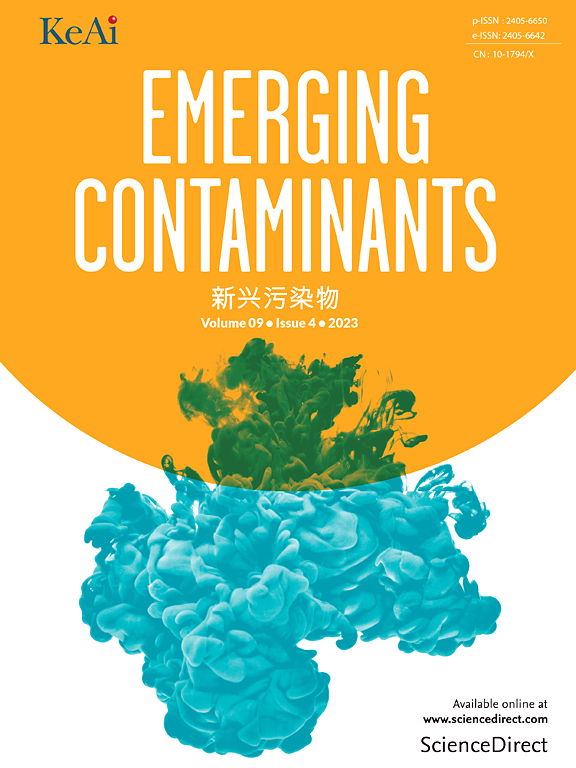Polychlorinated naphthalenes in the serum of individuals with thyroid dysfunction and their potential mechanisms of impact on disease progression
IF 6.9
2区 环境科学与生态学
Q1 ENVIRONMENTAL SCIENCES
引用次数: 0
Abstract
Polychlorinated naphthalenes (PCNs) comprise 75 congeners, with varying concentrations and major congeners across different populations. Recent studies have found a relationship between PCNs and thyroid hormone levels, suggesting they may interfere with thyroid function. Investigating the concentrations of PCNs in individuals with thyroid dysfunction helps identify the predominant congeners and enables targeted analysis of their interference with thyroid function. In this study, serum concentrations of PCNs from 55 adults with thyroid dysfunction were measured. PCN-13, -15, −17/25/26, −20, −23, and −24/14 detected at over 70 %, and PCN-23 and -24/14 being the major congeners. No significant difference in PCN concentrations was found between males and females, but the concentrations of PCN-23 and -24/14 increased with age. Logistic regression and QGC models revealed a significant association between PCN-23 and thyroid dysfunction, while mediation analysis indicated PCN-23 affects physiological processes involving the BRAF 600E gene, which influences normal thyroid function. Molecular docking results showed that all six PCNs impacted thyroid hormone metabolism and receptor binding, with PCN-23 binding more effectively to TBG and disrupting thyroid hormone transport compared to PCN-24/14. Future studies should focus on the concentrations of trichlorinated PCNs, particularly PCN-23, in the human body and their relationship with thyroid function.
甲状腺功能障碍患者血清中多氯萘及其对疾病进展影响的潜在机制
多氯萘包括75种同系物,在不同的人群中具有不同的浓度和主要同系物。最近的研究发现pcn与甲状腺激素水平之间的关系,表明它们可能干扰甲状腺功能。研究甲状腺功能障碍患者中pcn的浓度有助于确定主要的同系物,并能够有针对性地分析其对甲状腺功能的干扰。在这项研究中,测量了55名甲状腺功能障碍成人的血清PCNs浓度。PCN-13、-15、- 17/25/26、- 20、-23和-24/14的检出率超过70%,其中PCN-23和-24/14是主要的同源基因。PCN的浓度在雌雄之间无显著差异,但PCN-23和-24/14的浓度随着年龄的增长而增加。Logistic回归和QGC模型显示PCN-23与甲状腺功能障碍之间存在显著相关性,而中介分析表明PCN-23影响BRAF 600E基因的生理过程,从而影响正常的甲状腺功能。分子对接结果显示,6种pcn均影响甲状腺激素代谢和受体结合,与PCN-24/14相比,PCN-23更有效地结合TBG并破坏甲状腺激素运输。今后的研究应重点关注三氯pcn,特别是PCN-23在人体内的浓度及其与甲状腺功能的关系。
本文章由计算机程序翻译,如有差异,请以英文原文为准。
求助全文
约1分钟内获得全文
求助全文
来源期刊

Emerging Contaminants
Medicine-Public Health, Environmental and Occupational Health
CiteScore
10.00
自引率
6.70%
发文量
35
审稿时长
44 days
期刊介绍:
Emerging Contaminants is an outlet for world-leading research addressing problems associated with environmental contamination caused by emerging contaminants and their solutions. Emerging contaminants are defined as chemicals that are not currently (or have been only recently) regulated and about which there exist concerns regarding their impact on human or ecological health. Examples of emerging contaminants include disinfection by-products, pharmaceutical and personal care products, persistent organic chemicals, and mercury etc. as well as their degradation products. We encourage papers addressing science that facilitates greater understanding of the nature, extent, and impacts of the presence of emerging contaminants in the environment; technology that exploits original principles to reduce and control their environmental presence; as well as the development, implementation and efficacy of national and international policies to protect human health and the environment from emerging contaminants.
 求助内容:
求助内容: 应助结果提醒方式:
应助结果提醒方式:


